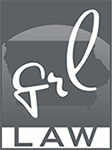In case you haven't heard, now that texting and driving is a primary offense in iowa, the State of Iowa is on an education campaign and law enforcement across the state is on a crusade to catch those who text and drive. Law enforcement's efforts are reported as even going undercover to catch text-happy offenders.
This enthusiastic enforcement of Iowa's new law may leave many wondering, what exactly can we do and not do on our cell phones while driving now. Others may want to know just how can law enforcement prove I was texting and driving in the first place. Finally, many people are still unclear on what the consequences are for drivers who are caught texting and driving. All of these are fantastic questions that GRL Law will answer in this three-part series. We start the series with what is prohibited under Iowa's texting while driving ban found in Iowa Code section 321.276.
What Is Prohibited?
Just what exactly am I prohibited from doing on my cell phone while driving? Can I place a phone call? Can I use my navigation app? Can I do a Google search? Can I tweet, update my Facebook status or Snapchat? Can I take a picture or video? Can I buy that new book I just heard about from Amazon?
The meat of the new law states: "A person shall not use a hand-held electronic communication device to write, send or view an electronic message while driving a motor vehicle unless the motor vehicle is at a complete stop off the traveled portion of the roadway."
What this means in English is that you can't use your cell phone (or any other portable communication device) to do any of the following while you are driving a motor vehicle:
- Write an electronic message;
- Send an electronic message; or
- View an electronic message.
There is not an exception if you are stopped at a stoplight or stop sign. If you want to write, send or view an electronic message while driving, you must stop your vehicle and pull completely off of the traveled portion of the roadway.
If you are thinking that the definition of "electronic message" strikes you as being important here, you would be 100% correct. "Electronic message" as defined in this law means, pretty much anything that displays on your phone. The legal definition is "images visible on the screen of a hand-held electronic communication device including a text-based message, an instant message, a portion of electronic mail, an internet site, a social medial application or a game."
Take a look at your phone right now. Everything that displays on it is an image. That being the case, a strict application of this definition would mean that you can’t even look at your lock screen clock or family picture. That would be viewing an image on your hand-held electronic communication device. Navigation apps seem to be out of the question too. Before you close out of this article in disgust, fear not. As with any law, there are exceptions. The current exceptions include the following:
- GPS & Navigation Systems – You may use a global positioning system or navigation system on your cell phone. Technically, you are not even prohibited from entering the address of where you are going while you are driving. We don't condone such behavior though because let’s face it, our hands belong on the steering wheel and our eyes belong on the road. That being the case, we are just telling you what the law says and this law does not prohibit you from entering information into a GPS or Navigation system.
- Phone calls – You may look at your phone to enter a phone number for purposes of placing a telephone call. Hands-free phone calls are not yet required in Iowa. You may still keep your cell phone plastered against your ear and chat happily away as you drive. Not the safest option but again, we are just telling you what the law does and does not prohibit.
- Receiving safety-related information – That weather alert from your local news; the Amber Alert; you may still receive those. You may still use your phone to receive safety-related information which includes emergency, traffic or weather alerts.
- Occupational exceptions – Police officer and other members of a public safety agency while performing their official duties, as well as health care professionals in the course of an emergency situation, are exempted from this law.
- Voice-to-Text – The texting ban only applies to "manual entry, transmission, or retrieval of an electronic message." It also does not prohibit a person from activating, deactivating or initiating a function of a hand-held mobile telephone. In other words, voice-to-text is currently legal.
While the new law certainly curbs the legal use of cell phones while driving, it does not completely prohibit all use. That begs the question – how does law enforcement prove a violation of this new law if phones may be used lawfully for certain functions? For that answer and other legal issues that may arise during enforcement efforts, make sure to catch Part II of this series coming soon.

